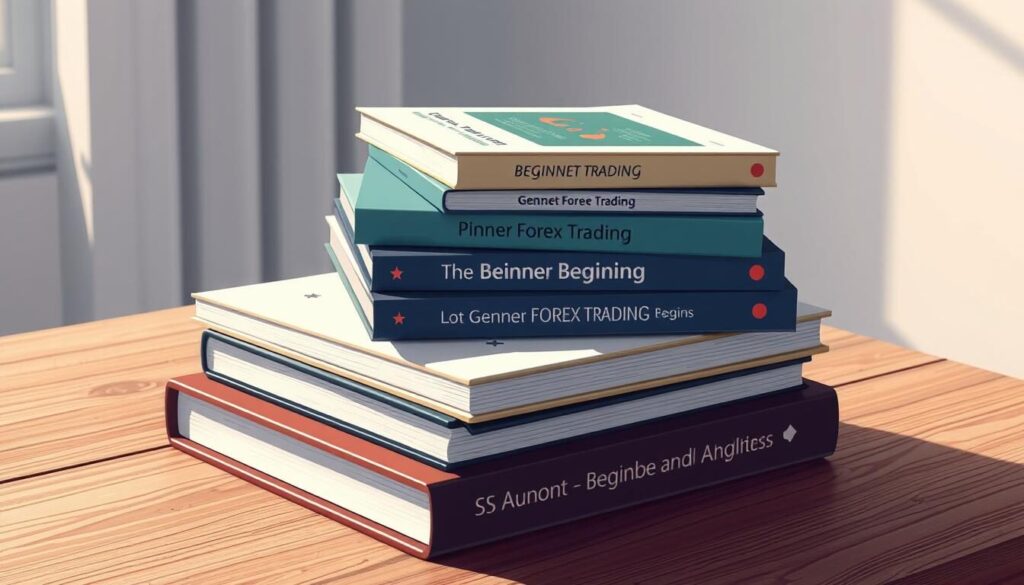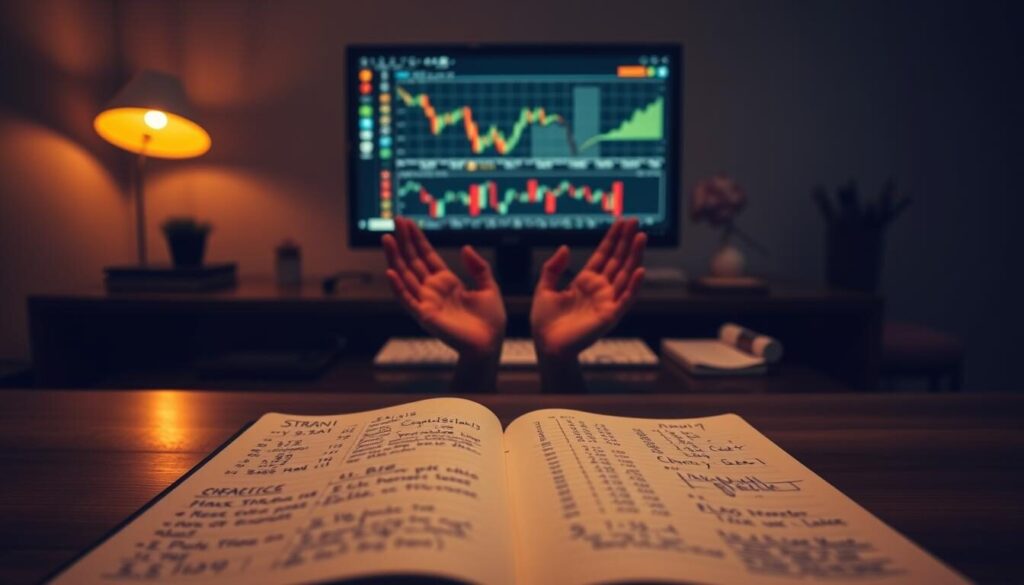Every single day, more money flows through global currency markets than the GDP of Japan and Germany combined. That’s right—$7.5 trillion changes hands before most of us finish our morning coffee. But here’s the kicker: 90% of new traders lose money in their first year. Why? They skip the step we’re about to unpack.
Think of a great book as your trading GPS. Without it, you’re just wandering through economic data and candlestick charts like a tourist without Google Maps. We’ve all been there—staring at platforms, wondering why EUR/USD moves like it’s allergic to predictability.
This guide isn’t about dry theories. We’re serving up battle-tested wisdom from legends like Kathy Lien (whose playbook combines technical analysis with real-world economics) and the “For Dummies” crew (because yes, even experts need reminders). You’ll find everything from broker selection hacks to decoding why the U.S. dollar dominates 88% of trades.
Best part? You don’t need to empty your account. Many resources we’ll explore are free or cheaper than a month of Netflix. Whether you’re decoding Steve Nison’s candlestick patterns or Courtney Smith’s profit strategies, consider this your backstage pass to smarter trading.
Key Takeaways
- The forex market trades $7.5 trillion daily—mastering it starts with quality education
- Books blend foundational knowledge with advanced tactics (like combining technical and fundamental analysis)
- Free/low-cost resources exist for every learning stage
- Proper broker selection is as crucial as strategy development
- Classic guides remain relevant alongside modern trading tools
- Risk management separates short-term gamblers from consistent earners
Introduction to Forex Trading Books
Understanding forex markets feels like trying to read a map upside-down in a rainstorm. Pips? Leverage? Margin calls? It’s enough to make anyone’s head spin faster than a roulette wheel. But here’s the secret: great guides turn chaos into clarity—like swapping tangled earbuds for noise-canceling headphones.
Overview of Forex Trading for Beginners
Imagine walking into a Tokyo fish market at 5 AM. Everyone’s shouting numbers, screens flash red and green, and you don’t speak the language. That’s forex without a roadmap. Books like the “For Dummies” series act as translators, breaking down concepts like bid-ask spreads into “buy low, sell high” realities.
| Confusing Term | Simplified Meaning |
|---|---|
| Leverage | Borrowed power (like using a crowbar for small moves) |
| Pip | Price’s heartbeat (0.0001 changes) |
| Margin Call | Broker’s “Hey, add funds” nudge |
How Books Shape Your Journey
Jim Brown’s “Basics Explained in Simple Terms” doesn’t just teach—it transforms. One chapter turns technical analysis from hieroglyphics into actionable patterns. Another demystifies risk management using burger-budget analogies (“Never bet your entire meal on one fry”).
These guides build confidence through structure. Learn why 74% of trades fail in the first month. Discover how to read price action like weather patterns. Most importantly? They remind you that even pros started clueless—we’ve all misclicked “sell” instead of “buy” at least once.
Why Reading Forex Books Is Essential

Ever tried assembling IKEA furniture without instructions? That’s trading without expert guidance—frustrating, time-consuming, and likely to leave you with wobbly results. Market veterans have already cracked the code on what works (and what explodes like a poorly built bookshelf).
Learning from Market Experts
Pros like Mark Douglas compare trading psychology to muscle memory: “Consistency isn’t something you do—it’s who you become.” Books transform abstract concepts into actionable plans. Think of technical analysis as learning to read weather patterns—spotting storm clouds (bearish signals) before they ruin your picnic.
| Concept | Expert Insight |
|---|---|
| Risk Management | “Never risk more than 2% per trade” – Courtney Smith’s burger budget rule |
| Price Patterns | Steve Nison’s candlesticks reveal market emotions like mood rings |
| Indicators | Kathy Lien treats RSI like a heartbeat monitor for currencies |
Real-life examples stick better than theory. One trader turned $500 into $50k using strategies from “Trade Your Way to Financial Freedom”—not by luck, but by mastering support/resistance patterns. These stories prove complex tools become simple with the right guide.
“Your first loss is your cheapest lesson.”
Every chapter plants seeds for smarter decisions. Whether it’s decoding Fibonacci retracements or spotting fakeouts, books give you a trader’s sixth sense. And unlike YouTube tutorials, they won’t vanish when your Wi-Fi does.
Top Rated Books: Currency Trading Fundamentals

Trying to learn forex without guidance is like baking a cake without a recipe—you’ll end up with a mess. Classic guides act as your kitchen timer, signaling when concepts are fully baked. Let’s crack open the oven light.
Decoding Market Mechanics
“Currency Trading for Dummies” turns forex jargon into plain English. Think of it as Google Translate for terms like “carry trade” or “liquidity pools.” One chapter compares candlestick patterns to emoji sequences—bearish engulfing? That’s the market flipping a table (╯°□°)╯︵ ┻━┻.
| Classic | Superpower | Real-World Hack |
|---|---|---|
| Forex Trading Bible | Strategy Blueprints | Treats stop-loss orders like seatbelts |
| Mastering Money Management | Risk Mitigation | 2% rule: Never bet two burgers on one trade |
| Art of Currency Trading | Pattern Recognition | Spots reversals like a barista senses burnt coffee |
Cementing Core Concepts
Brent Donnelly’s guides teach technical analysis through weather metaphors. Is that a head-and-shoulders pattern? Nope—just market clouds gathering before a storm. These tools help you predict squalls before they sink your portfolio.
Risk management gets the spotlight it deserves. One author compares leverage to skateboard ramps: “Bigger thrills mean harder falls.” Another uses pizza slices to explain position sizing—nobody wants eight slices of anchovy regret.
“Markets test your patience like a toddler testing ‘why’ questions.”
These guides bridge classroom theory and live markets. You’ll learn why 83% of trades fail without proper money rules. More importantly? They show how to be in the 17% club.
Best Forex Trading Books for Beginners

Picture trying to assemble a LEGO Death Star using only the force. That’s diving into currency markets without proper guides. Quality resources act like cheat codes—they reveal hidden patterns in price swings and turn confusing jargon into playground rules.
What Makes a Guide Actually Helpful?
Top-tier books share three traits: chapters that build like video game levels, explanations that stick like gumshoe metaphors, and exercises sharper than a sushi chef’s knife. Jim Brown’s classic turns complex strategies into “why didn’t I think of that?” moments using burger joint math.
Look for these green flags:
- Real chart examples showing wins and faceplants
- Glossaries translating “contango” to “uh-oh, prices might flip”
- Checklists simpler than microwave instructions
Titles That Don’t Treat You Like a Robot
Alex Nekritin’s Naked Forex strips indicators away like bad wallpaper—showing raw price action. It’s the trading equivalent of learning to swim without floaties. Meanwhile, “Currency Trading for Dummies” serves bite-sized lessons about swing moves between lunch breaks.
“Good trading feels like solving riddles—bad trading feels like the riddle solves you.”
Mix these perspectives like a DJ blends tracks. One day you’re spotting head-and-shoulders patterns, the next you’re calculating position sizes using pizza slice logic. Free PDFs from trading forums? They’re the samples at Costco—tasty previews before committing money to full courses.
Understanding Technical Analysis and Candlestick Patterns

Reading price charts without technical analysis is like using a smartphone without apps—you’ve got raw data, but zero superpowers. Steve Nison’s work reveals how 17th-century rice traders cracked the code of market psychology using candle shapes. Today, these patterns act as the market’s emoji language: 🟢 means “bulls are charging,” 🔴 signals “bears are hungry.”
Japanese Candlestick Charting Techniques Explained
Nison’s “Japanese Candlestick Charting Techniques” turns wicks and bodies into storytelling tools. A doji—where open and close prices hold hands—means indecision. It’s the market’s shrug emoji. Bullish engulfing? That’s green candles swallowing red ones whole, like Pac-Man chomping ghosts.
Three patterns every trader needs:
- Hammer: Bottom signals—picture a market hitting its head and bouncing back
- Shooting Star: Tops—like fireworks that fizzle instead of explode
- Morning Star: Reversals—the first sunlight after a dark night
Essential Technical Tools for Successful Trading
Technical indicators are your trading Swiss Army knife. John Murphy’s playbook pairs candlesticks with tools that go together like coffee and doughnuts:
| Tool | Purpose | Real-World Hack |
|---|---|---|
| Moving Averages | Trend GPS | 50-day crossing 200-day? Bullish highway ahead |
| RSI | Overbought/Oversold detector | Above 70? Market needs a nap |
| Fibonacci | Retracement predictor | 61.8% level: The market’s favorite rebound spot |
“Technical analysis is a compass, not a crystal ball—it shows direction, not destinations.”
Combine price action with these tools like DJ layers tracks. Spot a hammer at Fibonacci support? That’s your chorus kicking in. Use stop-losses as your volume knob—protect your account from ear-splitting losses.
Swing traders thrive on these combos. One strategy: Buy when RSI dips below 30 during uptrends—like grabbing discounted concert tickets before the band goes viral. Manage money like you’re splitting pizza: Never let one trade hog more than two slices.
Mastering Trading Psychology and Strategy

Building a profitable trading strategy without psychology is like doing CrossFit with noodle arms—you’ve got the moves, but zero staying power. Legendary trader Paul Tudor Jones once compared markets to dating: “You need the discipline to walk away when the chemistry’s wrong.”
Developing the Right Mindset for Trading
Mark Douglas’s “Trading in the Zone” reveals a brutal truth: Your worst enemy isn’t volatile markets—it’s the voice whispering “What if?” after every trade. Think of discipline as your mental seatbelt. Without it, even perfect technical analysis becomes useless during emotional rollercoasters.
Three mindset hacks from top performers:
- Treat losses like parking tickets—annoying but survivable
- Review trades like game film, not report cards
- Set rules tighter than airport security (“No revenge trades allowed”)
Case Studies: From Market Wizards to Trading Dummies
Take “The New Market Wizards” interviewee Tom Baldwin. He turned $25k into $2M by treating fear like bad GPS—acknowledging it, then ignoring it. Contrast that with “Dave,” a Reddit trader who blew his account chasing 100:1 leverage after one YouTube video.
| Trait | Market Wizard Approach | Common Mistake | Real-World Impact |
|---|---|---|---|
| Risk Tolerance | 2% per trade rule | YOLO-ing 50% on “sure things” | 17% vs 94% failure rate |
| Emotional Control | Journaling trades daily | Ignoring losing streaks | 42% better recovery rate |
| Adaptability | Updating strategies quarterly | Using 2015 methods in 2024 | 3x longer profitability |
“Successful habits compound faster than interest.”
Your turn: Next time the market zigzags, ask “What would Kathy Lien do?” Then breathe. Write down three rules before placing another trade. Remember—even chess masters started by learning not to leave their queen undefended.
Advanced Strategies for Day and Swing Trading
Day trading is like cooking stir-fry—high heat, quick flips, and constant attention. Swing trading? More like slow-roasting a brisket. Both fill your plate, but require entirely different kitchen skills. Let’s break down how pros like Kathy Lien use these approaches without burning their portfolios.
Speed vs Patience: Choosing Your Trading Rhythm
Scalpers thrive on 5-minute charts like hummingbirds sipping nectar. Swing traders watch daily patterns like farmers tracking weather. Your personality decides: Love adrenaline rushes? Day trading’s your espresso shot. Prefer marinating ideas? Swing trading’s your slow-drip coffee.
| Strategy | Tools | Mindset |
|---|---|---|
| Day Trading | 15-min charts, RSI, Volume spikes | “Cut losses faster than bad Tinder dates” |
| Swing Trading | Fibonacci levels, MACD, Weekly trends | “Let profits marinate like fine whiskey” |
Platforms offer advanced day trading playbooks with real-time scanners. These tools spot opportunities faster than a food critic detects truffle oil. Swing traders? They’ll love economic calendars highlighting next week’s inflation reports.
“Trade the market in front of you, not the one in your journal.”
Here’s the hack: Use Bollinger Bands® for day trades (narrowing bands = coming explosion). For swings, combine moving averages with support zones—like using GPS and road signs together. Rainy market days? Switch to range-bound strategies. Sunny trends? Ride momentum waves.
Remember: Day traders need exit plans tighter than airport security. Swing traders require patience thicker than peanut butter. Either way, manage risk like you’re babysitting a toddler near a staircase.
Utilizing Free Forex E-books for Continued Learning
Imagine walking into a library where every book is free and tailored to your current obsession. That’s what 80+ curated PDF resources feel like—organized sections ranging from price action basics to advanced day trading tactics. No library card required.
How to Access and Benefit from Free e-Books
These digital guides work like software updates for your trading brain. Want Jim Brown’s risk management hacks? Download. Need fresh takes on currency correlations? Click. Here’s your no-cost roadmap:
| Resource Type | Paid Version | Free Alternative |
|---|---|---|
| Strategy Guides | $29.99 e-book | PDFs from trading forums |
| Market Analysis | Monthly subscription | Archived broker reports |
| Psychology Manuals | $49 hardcover | University research papers |
Three steps to build your knowledge vault:
- Search “currency trading dummies PDF” + “[current year]”
- Sort results by file size (15-50MB usually means quality charts)
- Create folders like “Trend Theories” and “Case Studies”
Pro tip: Bookmark pages updating their list quarterly. Markets evolve faster than TikTok trends—yesterday’s breakout patterns might today’s false signals.
“Free resources are trading’s best-kept cheat codes.”
Treat your PDF collection like a spice rack. Sprinkle analysis techniques from different authors. Mix fundamental frameworks with technical sauces. Best part? You’re not risking grocery money to experiment.
Remember: Continuous learning separates the 9-to-5 grinders from the 4-hour-workweek traders. Next time markets feel overwhelming, crack open a free guide. Knowledge compounds faster than any trade.
Conclusion
Think of your trading journey like a road trip—quality guides are the playlist keeping you energized through every curve. From decoding price action rhythms to mastering the art currency trading mindset, each chapter you read adds another lane to your financial highway.
These resources transform confusion into clarity. Technical analysis becomes your weather app for market storms. Trading strategies turn into GPS reroutes around traffic jams. And psychology guides? They’re the caffeine keeping you alert during late-night chart sessions.
Here’s the beautiful part: Knowledge compounds faster than interest. That dog-eared book on foreign exchange basics? It’s your first stepping stone. Those free e-books gathering digital dust? They’re cheat codes waiting to be unlocked.
Imagine walking into the market with a map sketched by veterans. You’ll spot exit ramps before others brake. Recognize rest stops (support levels) where others see only asphalt. That’s the power of continuous learning.
Ready to shift gears? Download those PDFs. Join forums where traders dissect strategies like chefs critique recipes. Revisit chapters until candlesticks make sense as bedtime stories. Your next trade could be the one that turns theory into triumph.
We’re rooting for you—not just as readers, but as fellow travelers. Every master was once a rookie who refused to quit reading. Your next chapter starts now. And hey, if you get lost? The best guides are always within reach.
